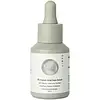What's inside
What's inside
 Key Ingredients
Key Ingredients

 Benefits
Benefits

 Concerns
Concerns

No concerns
 Ingredients Side-by-side
Ingredients Side-by-side

Water
Skin ConditioningPropanediol
SolventAzelaic Acid
Buffering1,2-Hexanediol
Skin ConditioningEthoxydiglycol
HumectantGlycerin
HumectantSodium Hydroxide
BufferingSalicylic Acid
MaskingMandelic Acid
AntimicrobialBifida Ferment Lysate
Skin ConditioningCapryloyl Glycine
CleansingSarcosine
Skin ConditioningCinnamomum Zeylanicum Bark Extract
AntimicrobialCamellia Sinensis Leaf Extract
AntimicrobialPotassium Sorbate
PreservativeSodium Benzoate
MaskingGluconolactone
Skin ConditioningBetaine
HumectantInulin
Skin ConditioningSodium Hyaluronate
HumectantWater, Propanediol, Azelaic Acid, 1,2-Hexanediol, Ethoxydiglycol, Glycerin, Sodium Hydroxide, Salicylic Acid, Mandelic Acid, Bifida Ferment Lysate, Capryloyl Glycine, Sarcosine, Cinnamomum Zeylanicum Bark Extract, Camellia Sinensis Leaf Extract, Potassium Sorbate, Sodium Benzoate, Gluconolactone, Betaine, Inulin, Sodium Hyaluronate
Water
Skin ConditioningButylene Glycol
HumectantEthoxydiglycol
HumectantGlycerin
HumectantSodium Hyaluronate
HumectantPanthenol
Skin ConditioningCopper Tripeptide-1
Skin ConditioningPhenoxyethanol
PreservativeEthylhexylglycerin
Skin ConditioningHydroxyethylcellulose
Emulsion StabilisingAloe Barbadensis Leaf Extract
EmollientSodium Gluconate
Skin ConditioningSodium Hyaluronate Crosspolymer
HumectantSodium Acetylated Hyaluronate
HumectantHydrolyzed Sodium Hyaluronate
Skin ConditioningPentylene Glycol
Skin ConditioningCamellia Sinensis Leaf Extract
AntimicrobialCI 61585
Cosmetic ColorantWater, Butylene Glycol, Ethoxydiglycol, Glycerin, Sodium Hyaluronate, Panthenol, Copper Tripeptide-1, Phenoxyethanol, Ethylhexylglycerin, Hydroxyethylcellulose, Aloe Barbadensis Leaf Extract, Sodium Gluconate, Sodium Hyaluronate Crosspolymer, Sodium Acetylated Hyaluronate, Hydrolyzed Sodium Hyaluronate, Pentylene Glycol, Camellia Sinensis Leaf Extract, CI 61585
Ingredients Explained
These ingredients are found in both products.
Ingredients higher up in an ingredient list are typically present in a larger amount.
Camellia Sinensis Leaf Extract is derived from the leaves of the tea plant. Black tea, green tea, and oolong tea are all harvested from this plant.
This ingredient has many skin benefits:
This ingredient contains polyphenols, a strong antioxidant. Antioxidants help fight off molecules that damage skin cells.
On top of that, the antioxidants in green tea neutralize free-radicals from the sun. This gives the skin some extra UV protection, but should not replace sunscreen.
Many components of tea have anti-inflammatory properties.
Polyphenols and L-theanine help soothe the skin and reduce irritation. The caffeine in Camellia Sinensis Leaf Extract helps calm inflamed blood vessels.
Other compounds found in tea include: Vitamin Bs, linoleic acid, magnesium, calcium, iron, and zinc.
Research has shown both drinking Camellia Sinensis Leaf Tea and applying it to the skin can help boost skin elasticity and hydration. Studies also show using tea extract may reduce sebum, or oil, production.
Learn more about Camellia Sinensis Leaf ExtractEthoxydiglycol is a synthetic solvent.
Solvents are used to keep ingredients together in a product. They can help dissolve ingredients to stable bases or help evenly distribute ingredients throughout the product.
Ethoxydiglycol also helps deliver other key ingredients into the skin.
Learn more about EthoxydiglycolGlycerin is already naturally found in your skin. It helps moisturize and protect your skin.
A study from 2016 found glycerin to be more effective as a humectant than AHAs and hyaluronic acid.
As a humectant, it helps the skin stay hydrated by pulling moisture to your skin. The low molecular weight of glycerin allows it to pull moisture into the deeper layers of your skin.
Hydrated skin improves your skin barrier; Your skin barrier helps protect against irritants and bacteria.
Glycerin has also been found to have antimicrobial and antiviral properties. Due to these properties, glycerin is often used in wound and burn treatments.
In cosmetics, glycerin is usually derived from plants such as soybean or palm. However, it can also be sourced from animals, such as tallow or animal fat.
This ingredient is organic, colorless, odorless, and non-toxic.
Glycerin is the name for this ingredient in American English. British English uses Glycerol/Glycerine.
Learn more about GlycerinSodium Hyaluronate is hyaluronic acid's salt form. It is commonly derived from the sodium salt of hyaluronic acid.
Like hyaluronic acid, it is great at holding water and acts as a humectant. This makes it a great skin hydrating ingredient.
Sodium Hyaluronate is naturally occurring in our bodies and is mostly found in eye fluid and joints.
These are some other common types of Hyaluronic Acid:
Learn more about Sodium HyaluronateWater. It's the most common cosmetic ingredient of all. You'll usually see it at the top of ingredient lists, meaning that it makes up the largest part of the product.
So why is it so popular? Water most often acts as a solvent - this means that it helps dissolve other ingredients into the formulation.
You'll also recognize water as that liquid we all need to stay alive. If you see this, drink a glass of water. Stay hydrated!
Learn more about Water